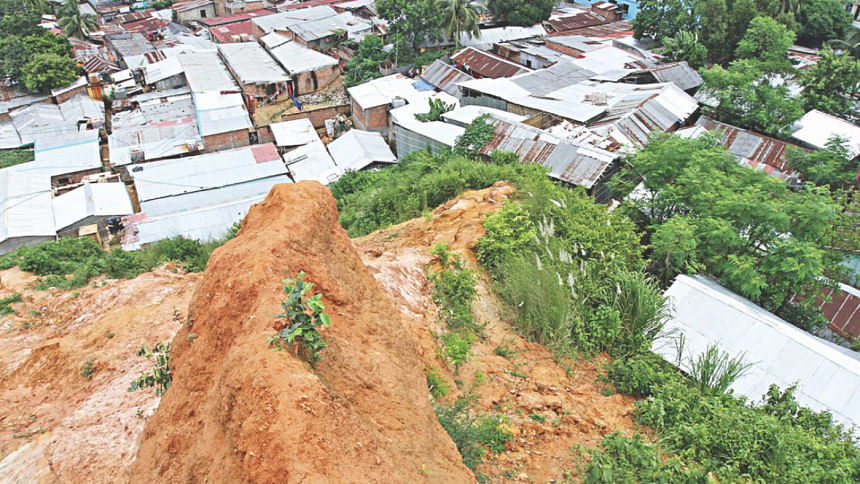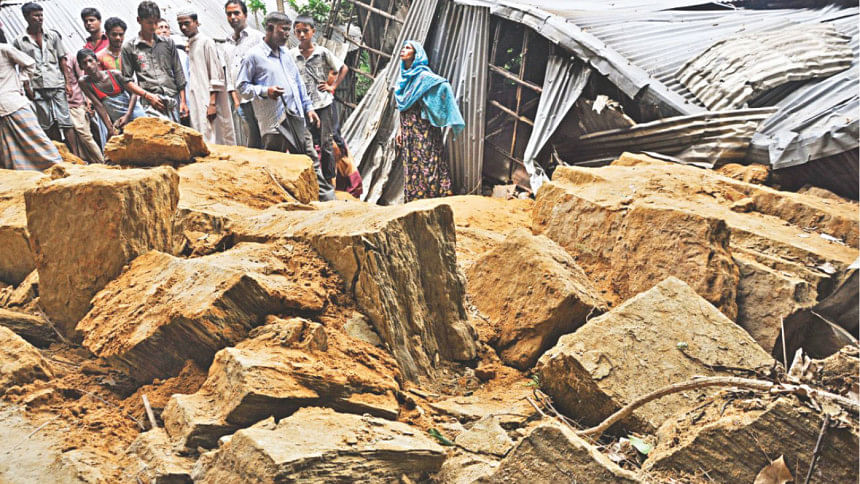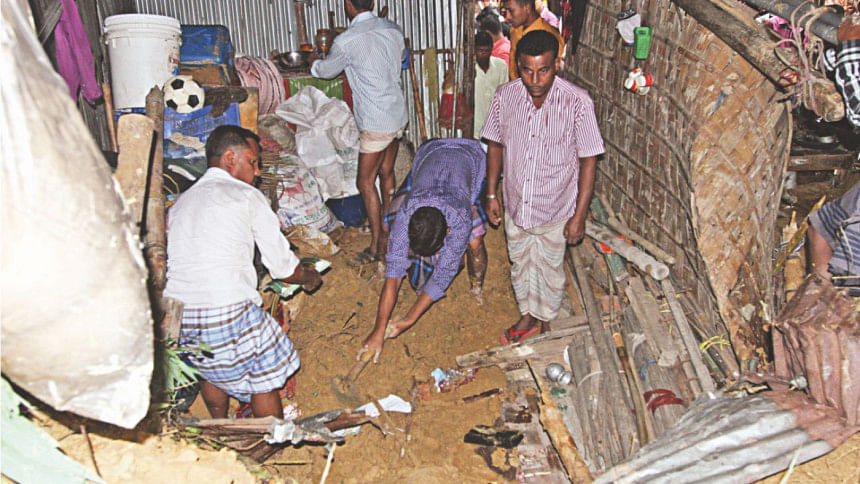Dwelling in a Death Trap

Just a day after Eid-ul-Fitr, the country's biggest religious celebration, we woke up to the news of the unfortunate deaths of a woman and five children, in three separate incidents of landslides and wall collapse at Bayazid and Lalkhan areas of Chittagong due to heavy rainfall. Following the incident, the voice of concerned government officials could be heard over loudspeakers, as they requested people to move to safer places.
We have a standard approach to tackle such sad news. News agencies reported the stories, concerned authorities held discussions where they presented a list of recommendations, we mourned idly before burying these traumatic deaths in the abyss of our minds until the arrival of the next monsoon.

Even though we put the blame on the heavy rainfall for these unfortunate and tragic deaths, we all are aware of other significant underlying reasons that are responsible for such tragedies.
This year's incident occurred after the government appointed the Hill Management Committee (HMC) which had identified 30 hills as being susceptible to landslides and recommended that the 666 families living in 11 of these danger zones are relocated. However, the number of dwellers living on the slopes and at the foot of the rest of the hills remains uncounted. Therefore, the actual and most current data remain unknown to us.

However, Md Abdullah, Divisional Commissioner of Chittagong who heads the HMC, claimed that they have already made a list and are working to improve the existing database. "Evacuating everyone at a time from all these identified areas is not practically feasible for the local government," Md Abdullah speaks about the eviction campaign, as he further adds, "We have a residential project for those who are living in danger. But it is a costly project. Our central government needs to actively advocate and participate in the evacuation and rehabilitation process to make it happen."
In 2008, the Hill Management Committee had selected 27 acres of khas land in Hathazari upazila to rehabilitate people affected by landslides. As this primarily selected land fell under the firing range of the Bangladesh Army, the committee selected 5.92 acres of land worth Tk 530 million at Jahan Ali Hat near Kalurghat Bridge, belonging to the Bangladesh Railway. There was a plan to set rehabilitation centres there for some 2400 families. But as this project failed, the people returned from Hathazari to the hills.
Experts blame the failure of different government offices who didn't take enough measures to prevent this vulnerable state of affairs in the hilly area. In 2007, following the most shocking mudslide in Chittagong city that took 127 lives, a divisional Hill Management Committee (HMC) was founded. Since then, the committee prepares short-term and long-term plans every year with a number of recommendations to combat such catastrophes.
Instead of executing the Chittagong Metropolitan master plan, in the name of "world class urbanisation" the Chittagong Development Authority started building residential areas, Kolpolok and Ononnya, in the two big flood lands of the city. As the prime rainwater harvesting area, the canals were filled up; as a result, the city was drowned by silt water.
Experts believe that like previous years, this year's flooding was also due to the filling of rivers and other water courses by the silting of those cut hills besides back tides. While developing these areas, individual companies and private owners cut a substantial amount of hills without reference to other parts of the hills, without considering the topography and the drainage catchment of the hills to ensure that other areas are not affected.

Excavating the existing sixteen canals and freeing them from illegal grabbers could also be attributed to the solution for water logging and the deaths caused by it, believes the newly elected city mayor AJM Nasir Uddin. "We have started working on evacuating the illegal settlements built over the canals and the alternative arrangements for all the electrical and telephone wires that pass through those canals. I believe the death rate has been substantially reduced and if all the stakeholders work together, we could come up with a solution." he says optimistically.
Moreover, concerned authorities and the owners of the marked hills had never taken steps to check hill cutting, felling of trees, and shifting of human settlements from the affected hill areas. However, in reality, the administration has not taken any step to demolish the risky structures in the danger zone. Instead, a group of opportunistic businessmen and political figures have been illegally grabbing different portions of hills by using muscle power, money power or political clout since time immemorial. They cut hills and illegally build makeshift houses, hills which are well equipped with utility connection and rented out to poor people, on the slopes and at the foot.
Muhammad Ali, a local resident claims that people who have political privilege are engaged with the hill cutting. "They encourage us to cut the hills to create a place for our habitat. However, after a heavy shower if the hill falls down, they reap the profit by selling the sediments at a high price." he says.
Interestingly, one of the former mayors during his tenure cemented a majority of the Chaktai Khal which cost around Tk. 50 crore. Experts were surprised at his decision, since a cemented canal cannot keep up with the increasing pressure of a growing population. In the name of development, he also occupied most of the city canals. Almost all 16 have been occupied by the City Corporation and private owners.

After the 2007 tragedy, the then caretaker government formed two committees to identify actual reasons behind the disaster. The committee submitted the reports on June 24 the same year when they identified 28 reasons for landslides in the hills.
They also suggested 36 procedures, including moving inhabitants from the hill slopes to avoid further loss of lives, building retaining walls to save the risky hills, etc. Even after all these years, the recommendations are yet to be implemented and people still live in homes built on the slopes of the hills.
The risks are higher for lower income residents of these hills due to hill cutting in areas like Matijhorna, Tanki Pahar Hill, Kaichchaghona, Lebubagan, Foy's Lake and Kusumbagh. Much of the government-owned land is occupied by local goons, who extract soil from these hills for housing projects and brick kilns.
"Last year during an eviction drive, many shacks illegally owned and managed by a former WASA official at Tankir Pahar were demolished." comments a local, who chooses to remain anonymous. "However, instead of carrying out any more eviction drives this year, the remaining dwellers were asked to evacuate the place, without even mentioning where we could go."
"In most cases, the middlemen who occupy and rent the land have no valid documents of possession; all they have is political clout. We prefer to live here because it is cheap compared to other places and we don't have any better place to move." he laments.
Photos: Prabir Das

 For all latest news, follow The Daily Star's Google News channel.
For all latest news, follow The Daily Star's Google News channel. 



Comments